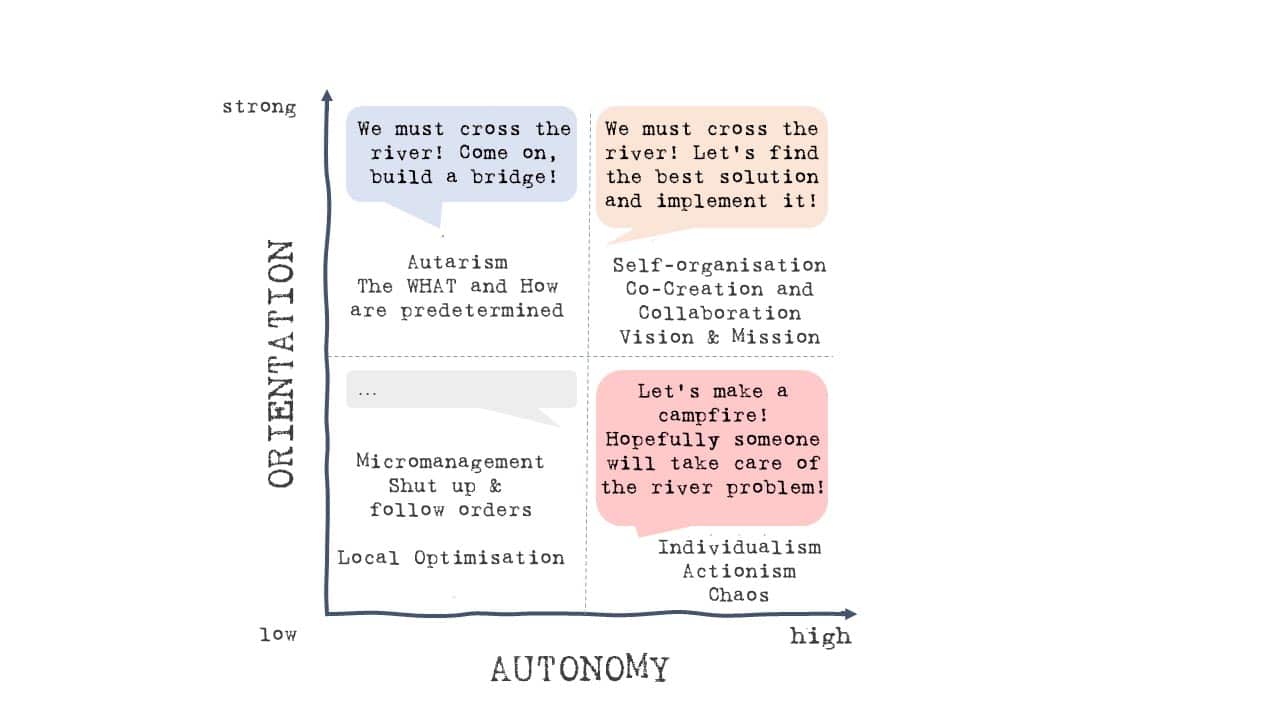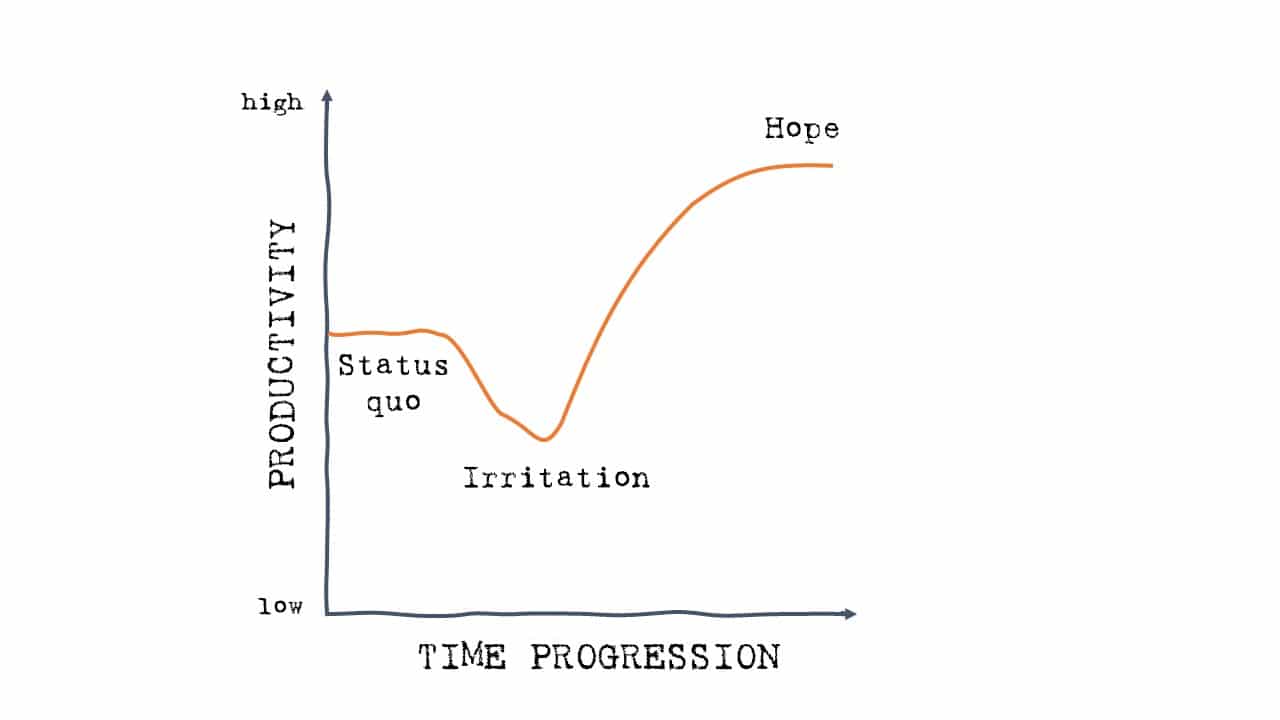Agility? We tried it! Does not work! – Part 5
Now it’s a few months since I wrote and published part 4 of this little series. A lot has happened during this time. And we have learned a lot. Much of what at the beginning of the year could still be dismissed in many companies as a “new work” utopia suddenly and inevitably became reality: home office, communication via video conferencing systems, use of digital whiteboards and other tools for online collaboration, which until then had rather been attributed to start-ups and the creative industry, arrived in corporations and medium-sized businesses. Sometimes from one day to the next, because it was absolutely necessary, sometimes only very carefully. I have been able to observe many positive things:
- An undreamt-of solution orientation of everyone in the provision of alternative solutions, in some cases it was probably the first situation in the history of many organisations in which “IT” was celebrated (or at least not scolded).
- Pragmatic solutions for dealing with temporary bottlenecks such as VPN in shift operation.
- In general, an incredibly steep learning curve when adapting to new conditions and using new tools.
- A higher level of cohesion and a “feeling of being in the same boat”, as everyone suddenly found themselves in an unfamiliar situation.
- Equalisation of regional distances: Suddenly it didn’t matter where you sat in your home office.
- More humanity among each other by being able to look into the living room or kitchen of colleagues and children and cats suddenly became very real.
- Many a manager has also been able to learn that his or her own employees work without constant supervision, sometimes even much more productively than before.
- …
Of course this is only half the truth. Of course there have also been problems. And of course many things work out much easier when you are in the same room.
But what does that have to do with agility in general and this series of articles in particular?
From my point of view, it is easy to recognise from the way we deal with this new situation, which is surprising for everyone, whether an organisation has really understood agility, takes it seriously and lives it. Take a look around your company: Is it trying to get back to the usual work organisation “before Corona” as well and as quickly as possible or do you take the time to reflect on this situation together?
My call to all who are serious about learning: Take the time for a Corona retrospective! (Or lockdown retrospective! Or home office retrospective! Or whatever is the most common term in your company to describe the special situation of the last months).
So a retro, ok. In the agile teams, of course. And also beyond, at departmental, divisional or even company level! Talk about it, across all levels: What have we learned, what has proven itself, what do we want to keep, where do we need better solutions, …? And in general: What can we learn from this crisis for future crises, even if the next crisis will be a completely different situation? How can we generally prepare ourselves better for unexpected crises?
Instructions on how to prepare and moderate such a retrospective, be it in virtual space or “classically” in suitable premises and taking into account current hygiene concepts, would go beyond the scope of this article. If in doubt, you can simply ask someone who is familiar with such things. (By the way, together with Olaf Hinz I offer such a format in German).
So back to the series of articles: The first article of my small series was mainly about the question whether agility is the right approach for organisations at all and if so, which concrete approach could fit which situation. The second part was mainly about typical problems with the introduction and implementation of agility. In this third episode the focus was mainly on the people themselves. In the fourth episode I tried to touch on some dangerous misunderstandings. And today I will take the ball of introduction and look at the handling of crises and learning in organisations.
Furthermore: This time again I will neither be able to provide universal solutions nor recipes for successful agility. The one or other attentive reader might recognise that my arguments are sometimes even contradictory. Welcome to reality: ambiguity is – according to experts – a characteristic or companion of complexity, in any case: unavoidable. And yet I am convinced that the inclined reader will be able to make sense of one or the other of my impulses.
And before we get started, let me point out once again that this article, too, may leave traces of irony!
You confuse agility with anarchy, part 3: Without leadership and common direction, you need not be surprised at the chaos that breaks out!
Self-organised teams, consisting of intrinsically motivated experts who develop successful products completely autonomously. All by themselves. As if by magic. That sounds very tempting, especially in crisis situations: Even if I, as a manager, do not know what the best solution is, even if I am overwhelmed and without orientation, even if I suddenly no longer have an eye on my team? Well then, let them show that this “agility” and self-organisation, which has been demanded so loudly for months, really works.
It can certainly work. But there is a lot to be said for the fact that it is bound to fail!
If the “freshly off the leash” team already shared a common vision and pursued a common mission before, if it knows for whom it is working and for what purpose, i.e. if there is a high degree of “alignment”, then the added autonomy can indeed be a liberation!
But if it used to be a group of individual experts who were individually supplied with work and controlled by the boss, without knowing an overall picture or even the context, then the new freedom can quickly lead to chaos.
In fact, I could observe many agile teams that became more productive during the crisis, when suddenly some non-agile control mechanisms in the office stopped working and some managers had to let go. But I have also heard of “teams” in which the new freedom was exploited by a few. Even if there may only be a few “black sheep” in the team, this frustrates the colleagues and in the worst case leads to a quasi implosion of team cohesion and productivity.
With his Alignment/Autonomy-Matrix Henrik Kniberg has presented what I think is a helpful model and thinking tool. (The fact that he sees a high degree of autonomy and a low level of alignment – in my illustration: orientation – as well as the danger of chaos breaking out, he also sees the opportunity for entrepreneurship, should not be our topic here today. I have therefore used two terms that are more appropriate for me, “individualism” and “actionism”).
At this point I would like to quote the great and unfortunately much too early deceased Prof. Kruse and his wonderful short lecture “8 rules for the total standstill in the company“: “The best thing you can do is: Try to have everything under control the whole time and then sometimes suddenly give complete freedom for the project!
So what to do? How does self-organisation and agility work?
Even at the risk of repeating myself: Unfortunately, there is not one solution that leads to success in all organisations. But there are certain principles which can help, which increase the probability that the path leads in the desired direction:
I think that the “7 Levels of Delegation” are a suitable model and Delegation Poker or Delegation Board can be helpful practices for negotiating the degree of autonomy together in a dialogue and for increasing it step by step in a targeted manner. Combined with regular retrospectives, this can help to learn together how to deal with more autonomy and to find the appropriate level together.
In addition, space and opportunity are also needed to work together in the team on alignment when this is no longer “dictated by the boss”. The development of a common vision/mission does not happen on the side and is not a one-off action but requires constant reflection and renewal to be truly effective. This is a challenge that good Scrum Masters or Agile Coaches never lose sight of. Also and especially not in times of crisis!
You simply let this “Agile Transformation” run on the side: If everyone wants to do it anyway, then it will run by itself and smoothly.
I can certainly understand that companies do not necessarily feel like embarking on the next large-scale reorganisation project, which then takes months or even years and does not really make anyone really happy – except perhaps legions of external consultants …
And agility and all this self-organisation should be a given, shouldn’t it? For years the call for it has been getting louder and louder! So all I have to do is let go and then the full potential of my employees is unleashed in a huge productivity explosion? Or does it?
Well. Could be. But probably not. But why not?
In Part 2 I had already pointed out the absurdity of wanting to order agility. An “All right, now you can, so go ahead” is, so to speak, just a more subtly expressed order and even worse: without taking responsibility for it yourself, without offering support.
In practice you never start from scratch, never on a white sheet of paper, never on a literally green field. Your employees might simply not be used to acting and deciding freely and self-organised, they have been accustomed to extrinsic incentives, command & control and micromanagement for months, years or even decades and have been socialised and conditioned in this way. This cannot simply be switched off and left behind at the push of a button. It takes time, patience and opportunities for new experiences.
No matter which model you look at or simply trust your own mind: change is always an irritation and requires attention and energy, which is initially at the expense of productivity.
Changes and irritations are manifold: A new expert strengthens the team, the team first deals with itself, how to communicate and work together until it has become newly (and hopefully on a higher) level. After a hard training session, an athlete is initially less efficient than before, before a new, hopefully higher level of performance is reached in the course of regeneration and supercompensation. Many athletes have also had the painful experience that “overtraining”, i.e. too many intensive stimuli without adequate regeneration, leads to a downward spiral. In office jobs the “burnout syndrome” would be a comparable phenomenon.
Now the lockdown, the spontaneous move to the collective home office, the switch to video conferencing etc. was already a massive irritation, with an often noticeable performance dip and rather limited hopes for a future increase in productivity above the previous level.
To hope that the parallel triggering or allowing of agility and self-organisation could lead to higher productivity in the medium term despite the crisis-like circumstances may seem a bit naive, but I like such optimism!
To think that two parallel irritations would not result in a performance dip, i.e. that the system would continue to run at full load and the changeovers would run “on the side” without any loss of productivity or even quality, would be really naive!
So what can you do? In my view, the two most important support measures are actually very simple – and yet so difficult in practice:
Give orientation! And if you yourself are lacking orientation in such an uncertain crisis situation, then use the diversity of your employees and invite them to create orientation together.
Invest sufficient time and support in change. If you don’t have time to sharpen your axe, you will – comparable to an athlete in “overtraining” – become increasingly unproductive over time. The early phase of change can be classically seen as an investment in future returns in the form of higher productivity.
If I leave the crisis situation aside, I find the first principles of Kanban after David Anderson as an approach to continuous and incremental change increasingly charming! Simplified in a nutshell: Start with the status quo and change in small steps and constantly. So no big bang, no months of conception and subsequent rolling out of new structures. The opportunity: The expected productivity slumps should be kept within limits. The danger: Inertia prevails and the changes are too small to have a chance.
If you want to increase the probability that small changes to more agility and self-organisation will succeed, then apply agile principles! Give space and time for communication, reflection and learning together. And let this process be accompanied by coaches and facilitators who help to unlearn old habits and discover and learn new practices. (See also: Part 2.)
You think that the brighter your future and the darker your past, the easier it is to change: Careful, that’s a pitfall!
In the previous paragraph I had already emphasised that you never start from scratch. This applies to every employee. And every team, every department and even the whole organisation shares a past. Common defeats, common failures, but also common successes.
Let us assume you are decision-makers in the company. You’ve either just been hired, perhaps just to bring in a bit of fresh air or even to sweep through things while there’s still something to sweep through. Or you are an integral part of the organisation. And you are convinced that agility will be the key to the future success of your company. And you trust your teams to do the same. And you want to get it right. You don’t want to beat about the bush. You want maximum openness, everything should be allowed to be questioned, nothing should be protected, just “because we’ve always done it this way”. Especially in the face of a massive crisis and upheaval, it is obvious that you have to look ahead and adapt to the new circumstances, that you have to completely reinvent yourself. That is why you paint your vision of the golden future in a particularly golden colour. And to make it as easy as possible for your employees to break away from old habits, draw the past one or two nuances darker than it was. Perhaps you have heard at some point that the success of the past is the reason for the failure of the future and you want to avoid that!
So far, so good.
Now let’s put ourselves in the position of a long-standing employee, middle management, not a high performer, but always loyal and reliable, a pillar of stability. You have always kept the business running, no matter how difficult it was at times.
How does it feel when you now hear that middle management, this so-called “paralysis layer”, i.e. you, will no longer be needed in the future? Because without it, things will run much faster and better thanks to this agility. How does it feel when earlier successes, of which you were all always proud, suddenly seem to be worth nothing? Without appreciation, your motivation to embrace change will probably be limited.
And other employees may also be watching very closely how existing decision-makers and top performers are dealt with before they become involved in the change. After all, when the next change comes, or the one after that, you may find yourself in the old iron and then you may not want to be treated like that.
It is complex.
Of course it would also be absurd to want to bring about change by praising the past and the status quo, which you would like to change and perhaps even have to change, over the green clover! But if you completely ignore the past or even charge it negatively, if you no longer mention well-known successes and take away the esteem of former top performers, then you are playing with fire!
This also closes the circle of introduction: it would be fatal not to appreciate the positive experiences of the crisis period! Even if you think or hope that you won’t have to survive a second lockdown so quickly, i.e. that you will need completely different skills in the future than, for example, the moderation of video conferences and the practiced use of digital whiteboards. Do not make the mistake of simply switching back to normal operation and “forgetting” the crisis as quickly as possible. You have certainly had some successes during the crisis – with a little appreciation your organisation can draw strength and confidence for the future from it, without appreciation a painful scar can remain.
Unfortunately, once again I do not have one solution at hand. But an approach based on Appreciative Inquiry seems to me to be very promising: finding the positive stories and strengths of the existing organisation in discussions, making them visible, appreciating them and building the new organisation on this foundation. And if I specifically look for “agile” aspects in the search and show, for example, that there has been successful self-organisation in the past, then this can help – as long as it does not seem too far-fetched … For the same reason, success stories that are explicitly based on non-agile principles and practices should not be swept under the carpet. Talk about it, find out together why it was a good and successful approach “back then” and why it might not be such a good idea today. A great opportunity for reflection and learning together!
One more thought: In the previous section I mentioned two models for change. Since change does not only mean new things but also saying goodbye to the past, I would like to suggest that we take a look at the phases of mourning and processing of separations (different models). On this basis, the reactions of people in phases of change can perhaps be better understood. You may even be able to derive suitable offers, for example how anger can be discharged without causing too much damage.
Outlook
I would be very happy if I could give you one or the other idea while reading, what might be the reason if agility does not work out as you would like it to. And maybe you have even found one or two helpful impulses for what you could do and try out differently.
By the way: There are several other aspects why agility does not work in companies. So there will definitely be another article. Be curious.
Notes:
Here you will find further parts of the series entitled Agility? We tried it! Does not work!

Heiko Bartlog
Heiko Bartlog has more than 25 years of experience in projects, as a consultant, trainer, coach and entrepreneur, covering many different areas. As a ‘host for co-creation’, he supports organisations on their path to good cooperation and successful development. His repertoire includes approaches such as Scrum, Effectuation, Lean Startup, Management 3.0 and Liberating Structures. As a ‘mentor for mental fitness and vitality,’ he supports leaders in unlocking their potential.




